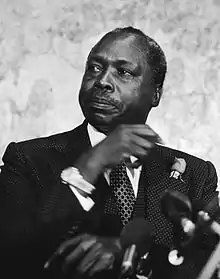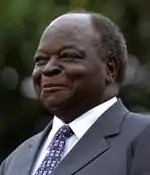1992 Kenyan general election
General elections were held in Kenya on 29 December 1992. Voters elected the President, and members of the National Assembly. They were the first multi-party general elections in Kenya since independence and the first to feature a direct vote for the President, who had, in 1964, been elected by the National Assembly, and, following a 1969 constitutional amendment, been automatically declared winner of non-held popular elections, held alongside parliamentary elections, in 1969, 1974, 1979, 1983, and 1988.
| |||||||||||||||||||||||||||||||||||||||||
| |||||||||||||||||||||||||||||||||||||||||
| |||||||||||||||||||||||||||||||||||||||||
1992 Kenyan parliamentary election | |||||||||||||||||||||||||||||||||||||||||
This lists parties that won seats. See the complete results below. | |||||||||||||||||||||||||||||||||||||||||
| |||||||||||||||||||||||||||||||||||||||||
.svg.png.webp) |
|---|
| This article is part of a series on the politics and government of Kenya |
|
|
The results were marred by allegations of large-scale intimidation of opponents, harassment of election officials, and ballot-box stuffing, as well as targeted ethnic violence in the Rift Valley Province. Human Rights Watch accused several prominent Kenyan politicians, including President Daniel arap Moi and then-VP George Saitoti of inciting and co-ordinating the violence.[1] Voter turnout was 69.4%.[2][3]
Background
In 1991, Kenya transitioned to a multiparty political system after 26 years of single-party rule under KANU. On 28 October 1992, president Moi dissolved parliament, five months before the end of his term. As a result, preparations began for all elective seats in parliament as well as the president. The elections were scheduled to take place on 7 December 1992, but delays led to its postponement to 29 December the same year.
Results
President
| Candidate | Party | Votes | % |
|---|---|---|---|
| Daniel arap Moi | Kenya African National Union | 1,927,645 | 36.6 |
| Kenneth Matiba | FORD–Asili | 1,354,856 | 25.7 |
| Mwai Kibaki | Democratic Party | 1,035,507 | 19.6 |
| Jaramogi Oginga Odinga | FORD–Kenya | 903,886 | 17.1 |
| Chibule wa Tsuma | Kenya National Congress | 15,393 | 0.3 |
| George Anyona | Kenya Social Congress | 14,253 | 0.3 |
| John Harun Mwau | Party of Independent Candidates of Kenya | 10,449 | 0.2 |
| David Mukaru Ng'ang'a | Kenya National Democratic Alliance | 8,527 | 0.2 |
| Invalid/blank votes | – | ||
| Total | 5,270,516 | 100 | |
| Registered voters/turnout | 7,956,354 | ||
| Source: Nohlen et al. | |||
By province
| Province | Moi | Matiba | Kibaki | Odinga | Others | Total | ||||||
|---|---|---|---|---|---|---|---|---|---|---|---|---|
| Votes | % | Votes | % | Votes | % | Votes | % | Votes | % | |||
| Central | 21,918 | 2.1 | 630,194 | 60.4 | 373,147 | 35.8 | 10,668 | 1.0 | 6,945 | 0.7 | 1,042,872 | |
| Coast | 188,296 | 62.1 | 33,399 | 11.0 | 32,201 | 10.6 | 42,796 | 14.1 | 6,653 | 2.2 | 303,345 | |
| Eastern | 290,372 | 37.0 | 79,436 | 10.1 | 392,481 | 50.0 | 13,673 | 1.7 | 8,819 | 1.1 | 784,781 | |
| North Eastern | 46,420 | 74.8 | 7,188 | 11.6 | 3,259 | 5.3 | 5,084 | 8.2 | 73 | 0.1 | 62,024 | |
| Nairobi | 62,410 | 16.6 | 165,553 | 44.1 | 69,715 | 18.6 | 75,888 | 20.2 | 1,944 | 0.5 | 375,510 | |
| Nyanza | 117,554 | 15.2 | 10,299 | 1.3 | 51,998 | 6.7 | 581,490 | 75.4 | 9,807 | 1.3 | 771,148 | |
| Rift Valley | 981,488 | 71.5 | 214,727 | 15.6 | 98,302 | 7.2 | 75,465 | 5.5 | 3,535 | 0.3 | 1,373,517 | |
| Western | 219,187 | 39.3 | 214,060 | 38.4 | 14,404 | 2.6 | 98,822 | 17.7 | 10,846 | 1.9 | 557,319 | |
| Total | 1,927,645 | 36.6 | 1,354,856 | 25.7 | 1,035,507 | 19.6 | 903,886 | 17.1 | 48,622 | 0.9 | 5,270,516 | |
| Source: Nohlen et al. | ||||||||||||
National Assembly
Following the elections, Moi appointed a further 12 KANU members to the National Assembly.[4]
| Party | Votes | % | Seats |
|---|---|---|---|
| Kenya African National Union | 1,327,691 | 24.5 | 100 |
| FORD–Asili | 1,118,247 | 20.6 | 31 |
| Democratic Party | 1,016,049 | 18.7 | 23 |
| FORD–Kenya | 928,364 | 17.1 | 31 |
| Kenya National Congress | 87,788 | 1.5 | 1 |
| Party of Independent Candidates of Kenya | 42,109 | 0.8 | 1 |
| Kenya Social Congress | 17,133 | 0.3 | 1 |
| Kenya National Democratic Alliance | 771 | 0.0 | 0 |
| Social Democratic Party | 177 | 0.0 | 0 |
| Invalid/blank votes | 61,173 | – | – |
| Total | 5,486,768 | 100 | 188 |
| Registered voters/turnout | 7,900,366 | 69.4 | – |
| Source: Nohlen et al. | |||
Aftermath
In the aftermath of the election, Kenya suffered an economic crisis propagated by ethnic violence as the president was accused of rigging electoral results to retain power.[5] 5,000 people were killed and a further 75,000 others displaced from their homes.[6] In the next five years, many political alliances were formed in preparation for the next elections. In 1994, Jaramogi Oginga Odinga died and several coalitions joined his FORD Kenya party to form a new party called United National Democratic Alliance. However, this party was plagued with disagreements. In 1996, KANU revised the constitution to allow Moi to remain president for another term.
In 1993 Kenneth Matiba filed a petition against the election results. However, his failure to personally sign the petition resulted in the petition being struck out by Justice Riaga Omolo. Matiba, was physically incapacitated and had given his wife power of attorney. In 2012, Justice Omolo was declared unfit to serve in the judiciary by the Judges and Magistrates Vetting Board over this decision.[7]
References
- Human Rights Watch (1993), Divide and Rule: State Sponsored Ethnic Violence in Kenya
- Elections held in 1992 Inter-Parliamentary Union
- Nohlen, D, Krennerich, M & Thibaut, B (1999) Elections in Africa: A data handbook, p486 ISBN 0-19-829645-2
- Elections in Kenya African Elections Database
- Keith., Kyle (1999). Politics of the independence of Kenya. Macmillan. ISBN 978-0333720080. OCLC 795968156.
- "Clashes, elections and land - church keeps watch in Molo". IRIN. 19 July 2007. Retrieved 29 January 2019.
- Why this election may be won in courts The Star, 12 January 2013



.jpg.webp)